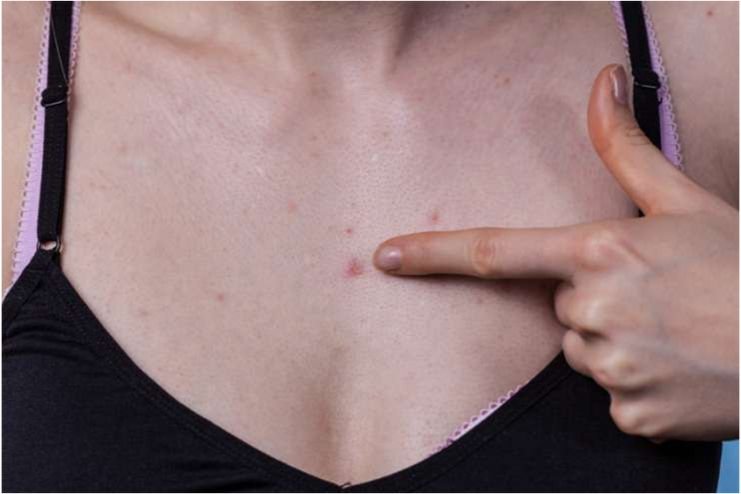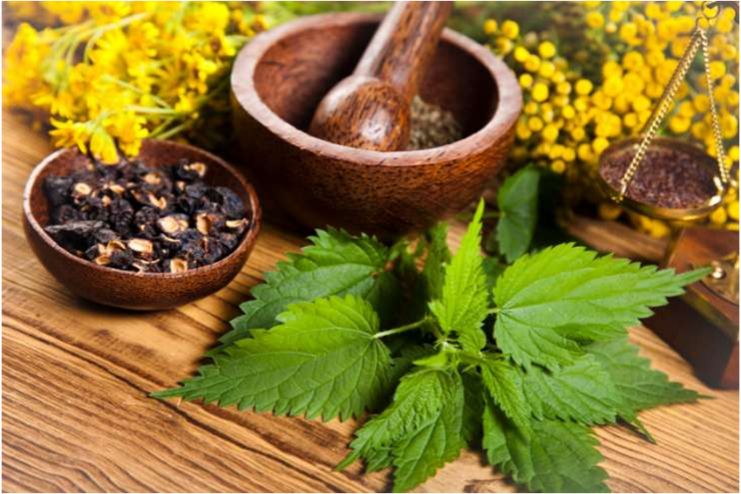Affiliate Disclaimer
Some links in this article are affiliate links. We may earn a small commission if you make a purchase through these links, at no extra cost to you. We only recommend products we find useful to our readersChest acne is a common skin problem that most people may have at some point in their lives. The intensity varies, ranging from tiny whiteheads and blackheads to painful cystic nodules, and it frequently links to acne on the face, shoulders, and back. Even though it may not receive as much attention as acne on the face, it may still be just as annoying, particularly in the warmer months when swimwear and tank tops are popular.
Unexpectedly, chest acne affects people of all ages, including athletes who sweat frequently, adults who balance hectic schedules, and kids going through puberty. Given how often dermatologists see this problem, it’s critical to comprehend the reasons for chest acne and the prevention and treatment strategies.
This article covers important details about chest acne, including causes, remedies, and prevention.
What Is Chest Acne?
Acne on the upper chest is known as chest acne. It usually develops in regions where the skin folds, including the space between or beneath the breasts and the chest muscle. These areas easily retain sweat. Chest acne, which is more common in warm, humid regions and affects both men and women, is primarily caused by sweat.
Notably, those who already have acne in other places are more likely to get chest acne. However, it can also happen to people who have never had acne before. It is a lot like acne on the back.
Chest acne can appear in a variety of ways:
- Whiteheads are tiny, elevated pimples with a white core brought on by clogged pores.
- Open pores become blackheads when dead skin and oil block them, and exposure to air causes them to darken.
- The most severe acne, known as cystic acne, is typified by deep, painful, and inflammatory cysts that can cause scarring and last longer.
Causes of Chest Acne?

There are various reasons why chest acne can occur. Knowing the different reasons behind chest acne is essential. Some of the major reasons are listed below:
1. Dehydration
Dehydration has a negative impact on all aspects of a person’s health, including the skin. When the body is dehydrated, the skin tends to become dry and flaky. This dryness prompts the skin to produce more oil. As a result, if the flakes get trapped in overly greasy pores, it can worsen acne.
2. Body Moisturizer
Although using noncomedogenic cosmetics on the face has grown in popularity, many people still apply heavier, scented creams to their chests. These products block pores more and start the acne-causing chain of events.
3. Sweat Trapped
The creases of the chest naturally trap sweat, but tight-fitting clothing and specific undergarments worsen the problem by keeping moisture trapped all day.
4. Sugar-Filled Meals
Fast blood sugar rises from sugary foods, which can cause acne on the chest and other acne-prone areas. If sugary foods worsen your acne, reduce your sugar intake.
5. Exercise
Exercise usually keeps individuals healthy, but for some people, it might cause chest acne. Acne on the chest can be brought on by sweat and friction from the skin rubbing against clothing. Wearing loose-fitting clothing and showering soon after doing exercise might help avoid this.
6. Cleaners and Soaps
Perfumes and colognes, strongly scented laundry detergents, or even detergent residue on clothing can irritate the skin, cause inflammation, and result in acne, especially in people with sensitive skin.
7. Changes in Hormone Levels
Hormones can also contribute to older women’s period-related acne on or near their breasts, even though it’s usually typical in adolescents and young adults. The fluctuating hormones and friction from the breast enlargement could bring on an acne outbreak.
Home Remedies for Chest Acne

1. Oil of Tea Tree
Tea tree oil is a popular alternative skin care product for acne and other ailments. According to Mayo Clinic, products containing 5 percent of this oil may function as effectively as those containing 5 percent benzoyl peroxide. But patience is the key. Compared to traditional treatments, tea tree oil acts a little more slowly.
2. Charcoal or Mud
Consider using a mud or charcoal mask if you prefer a natural remedy already prepared in a container. These can be applied to specific chest areas or utilized as all-over treatments. Charcoal and mud both remove pollutants, which helps treat acne. At the same time, these compounds could make your skin softer.
3. Aloe Vera Gel Mask for Relaxation
Aloe vera is a great way to soothe inflamed skin and encourage healing because of its calming, anti-inflammatory, and antibacterial qualities. A study published in the Indian Journal of Dermatology claims that aloe vera gel is an excellent way to combat bacteria and reduce inflammation. To use, generously coat the afflicted area with fresh gel extracted straight from the aloe vera plant. Rinse it with warm water after 15 to 20 minutes to reveal calmed and revitalized skin.
4. Apple Cider Vinegar
Apple cider vinegar is an excellent natural remedy for treating chest acne and is known for its ability to balance skin’s pH levels. Creating an alkaline environment makes it difficult for bacteria to thrive and penetrate the skin. Soak a small cotton ball in a tablespoon of apple cider vinegar and gently rub it over the affected area. Leave it on for 30 minutes or overnight, then rinse it off with fresh water for clear, healthier skin.
5. Cinnamon and Honey
Cinnamon’s potent antimicrobial properties make it an effective remedy for chest acne. These properties help eliminate harmful bacteria that cause inflammation. Combined with honey, a natural antibiotic, this duo becomes even more potent in combating acne.
To use this remedy, thoroughly wash the entire chest area and pat it dry. Next, prepare a paste by mixing honey and cinnamon powder in equal amounts. Apply the paste evenly to the affected area and let it sit for 15–20 minutes.
Finally, rinse it off with water and allow the skin to air dry. When used consistently, this simple yet effective method can help soothe inflammation and promote clearer skin.
6. Baking Soda
A baking soda exfoliating scrub is a valuable treatment for chest acne. It gently eliminates dead skin cells, extra oil, and contaminants that block pores. In addition to clearing up current acne, this exfoliation method prevents outbreaks from happening again and encourages smoother skin.
As required, make a paste with at least two teaspoons of baking soda and a few drops of water. Apply the paste in circular motions to the afflicted region, then thoroughly rinse with warm water to achieve clear, renewed skin.
How Can Chest Acne Be Treated?
You must regularly care for your skin to treat acne. Numerous options for treating chest acne can help prevent skin scarring, reduce the visibility of acne, and lessen the emotional strain it causes.
To prevent congested pores, use noncomedogenic lotions and mild cleansers. Also, avoid rough or harsh body washes, which can aggravate acne and harm the skin.
Gels, Lotions, and Creams Available Over-the-Counter
- Adapalene, 0.1% gel, is a retinoid medication that prevents pimples from developing beneath the epidermis.
- Benzoyl peroxide comes in different strengths and kills bacteria.
- One common ingredient used to treat skin-surface acne is salicylic acid.
Start with a small amount of a new product and gradually increase its frequency of use over time. It could take up to eight weeks or more to notice changes in your skin, so be patient with the outcomes.
Tips to prevent chest acne

Follow some important tips listed below to prevent the problem of chest acne.
- Take a shower every day. It helps to eliminate bacteria from the surface of the skin. Regular exfoliation is also recommended.
- Always wear cotton or natural fiber clothes, especially during summer. This helps keep sweat away from the clothes.
- Also, try to change your sweaty clothes immediately and wipe all the sweat on your chest with a towel. Wipe the sweat from other body parts as well, like your back.
- Do not scratch the area when trying to get rid of acne. Healing on the chest does not occur as quickly as on the face, and scars can also form quickly. Experts recommend using salicylic gel right after a shower to prevent acne development.
- Seek out noncomedogenic or sensitive skin-formulated body products that are mild and odorless.
- Antibacterial soap can avoid inflammatory acne. Bacterial accumulation, mainly behind closed pores, can cause acne. Seek out soaps that contain benzoyl peroxide, an antibacterial agent that aids in clearing blocked pores.
Conclusion
Although chest acne may seem like an impossible obstacle, it is entirely possible to achieve smoother, healthier skin with the correct knowledge and strategy. You have a range of solutions to suit your needs, from efficient over-the-counter treatments to natural cures. Consistency, patience, and a readiness to modify your skincare regimen are necessary for acne-free skin.
-
Aug 2017Written by Prajakt
-
Dec 2024Edited by Ankita
References
- https://www.medicalnewstoday.com/articles/320973
- https://www.mayoclinichealthsystem.org/hometown-health/speaking-of-health/what-to-do-about-chest-acne
- https://www.mayoclinichealthsystem.org/hometown-health/speaking-of-health/the-facts-about-chest-acne
- https://my.clevelandclinic.org/health/diseases/12233-acne
- https://www.healthshots.com/beauty/natural-cures/chest-acne
In this Article



















